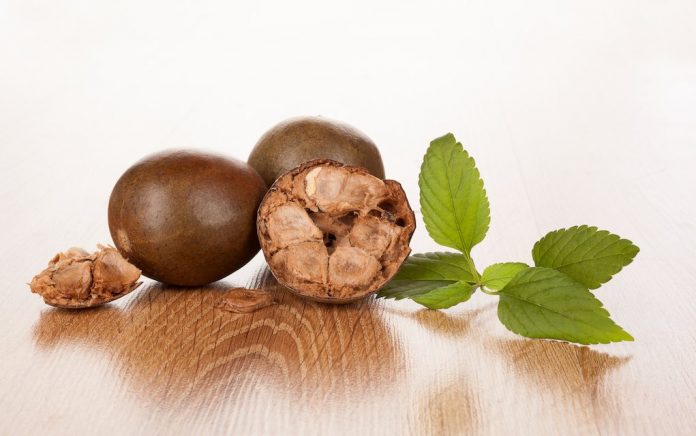
If you are looking for a healthy, safe natural alternative to sugar and sugar-related sweeteners, one option that hasn’t gotten the attention it deserves is monk fruit. We are going to change that right now, so get ready for some significant sweetness, courtesy of the luo han guo (aka, monk fruit or Siraitia grosvenorii).
Monk fruit 101
Luo han guo is a melon-like fruit that is indigenous to Thailand and parts of China. Buddhist monks reportedly first used the fruit in the 13th century, which is where it gets its name. This calorie-free sweetener is produced by juicing the yellow-brown or green-brown fruits, which are about the size of limes, and processed into crystal form or into a liquid. You can also find the sweetener in the form of a powder.
Read about a guide to natural sweeteners
What does monk fruit taste like?
The fruits owe their incredible sweetness to antioxidant compounds called mogrosides. Depending on the mogroside content of the fruits, monk fruit sweetener can be 100 to 250 times sweeter than table sugar, so a little goes a long, long way!
You probably would not want to eat the fruit like an apple, since it is not appealing. The sweetener is made from the fruit’s extract, which is sometimes mixed with other sweeteners such as dextrose, maltodextrin, erythritol, or stevia. This is often done to offset or balance the intense sweetness of the mogrosides. Some people find the taste of the extract to be unpleasant or to have an aftertaste.
Monk fruit benefits and safety
When we compare monk fruit sweetener with sugar, the benefits begin to add up. For example:
- No calories. Monk fruit extract contains zero calories, which makes it appealing for anyone who is watching their caloric intake. It also is a healthy alternative to artificial no-calorie sweeteners, such as acesulfame, aspartame, neotame, saccharin, and sucralose.
- No carbohydrates. This feature is a plus for those who are following a low-carb diet. So the answer to the question, is monk fruit keto friendly, the answer is yes!
- No sugar. Pure monk fruit extract contains no sugar, which means it has no impact on blood sugar levels
- No side effects. Is monk fruit safe? According to the Food and Drug Administration (FDA), this sweetener is GRAS (generally regarded as safe). No harmful side effects have been reported from using this product, nor have there been any monk fruit allergy symptoms noted.
Read about 7 reasons artificial sweeteners are terrible for us
Mogrosides and diabetes
Thus far, research on the effect of using monk fruit for diabetes has been done only in animals. However, the findings indicate that mogroside extracts may help prevent diabetic complications and that they have an ability to control blood sugar levels. In this latter case, it’s been proposed that the mogrosides may stimulate the release of insulin, which in turn improves the movement of glucose (sugar) out of the bloodstream to help regulate blood sugar levels.
When we look at monk fruit and the glycemic index, the sweetener lies well within the low zone. In fact, the sweetener is sometimes referred to as a non or zero glycemic product.
How to buy and use monk fruit sweetener
When buying a monk fruit sweetener, be sure to read the label to see if other ingredients have been added. The addition of other substances can affect how natural the end product is, as well as its nutritional value and caloric content. Also be sure no potential allergens have been used in the manufacture of the sweetener if you have such intolerances.
The extract is heat stable, so you can use it for baking and cooking. However, you cannot use it as a simple direct replacement for sugar in your recipes. When you use sugar alternatives, you need to allow for differences not only in sweetness but in volume and texture as well. Your best bet is to use recipes that specifically spell out how much of the sweetener you should use, or you can refer to this chart to help you make substitutions.
Bottom line
Whether you have been using monk fruit sweetener for some time or you are new to the concept, let us know what you think. How have you used the sweetener? What do you think of the taste? Tell us about any of your recipe successes or mishaps!
Read This Next
Is this "Healthy" Ingredient Actually Harmful
Jelly Belly Jelly Beans & Other Candy
Sources
Food and Drug Administration. Additional information about high-intensity sweeteners permitted for use in food in the United States. Luo Han Guo fruit extracts. 2018 Feb 8
Hand J. How to bake with sugar substitutes. BulletProof blog
Johnson J. What are monk fruit and stevia? Medical News Today 2018 Aug 15
Liu H et al. Antiglycation and antioxidant activities of mogroside extract from Siraitia grosvenorii (Swingle) fruits. Journal of Food Science Technology 2018 May; 55(5): 1880-88
McDermott A. Monk fruit vs stevia: which sweetener should you use? Healthline 2016 Apr 15
Xu Q et al. Antioxidant effect of mogrosides against oxidative stress induced by palmitic acid in mouse insulinoma NIT-1 cells. Brazilian Journal of Medical and Biological Research 2013 Nov; 46(11): 949-55
Zhou Y et al. Insulin secretion stimulating effects of mogroside V and fruit extract of luo han uo (Siraitia grosvenori Swingle) fruit extract. Yao Xue Xue Bao 2009 Nov; 44(11): 1252-57


![[Savvy Swaps] Wipes savvy swap wipes](https://naturallysavvy.com/wp-content/uploads/2021/11/NaturallySavvy_Savvy-Swap-Cleansing-Wipes_Twitter_RR_21-June-21_V1_R1-218x150.jpg)

![[Savvy Swaps] Energy Drinks Savvy Swap Red Bull Energy Drink Uncle Matt's](https://naturallysavvy.com/wp-content/uploads/2019/02/NS_SwapEnergyDrinkRedBullMatts5x5_6-1-218x150.jpg)

![[Savvy Swaps] Protein Powder Naturade Plant-Based Protein VeganSmart Savvy Swap](https://naturallysavvy.com/wp-content/uploads/2019/12/NS_SwapProteinPowderNaturade5x5_2-218x150.jpg)
![[Savvy Swaps] Antacid Lily of the Desert Savvy Swap Antacid](https://naturallysavvy.com/wp-content/uploads/2018/11/NS_SwapAntacidLilyOfTheDesert5x5_2-1-218x150.jpg)


